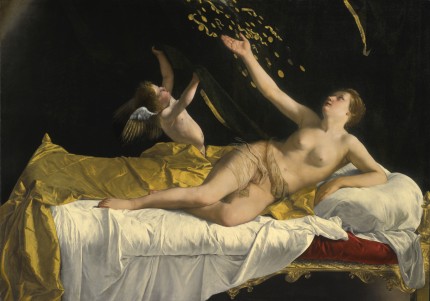
The J. Paul Getty Museum blew through the record for Baroque artist Orazio Gentileschi when it bought his Danaë at a Sotheby’s auction Thursday for $30.5 million. That’s more than seven times greater than the previous record of $4,117,803 set in 2007 with the sale of a Madonna and Child. The entire sale of 61 lots took in a comparatively meager total of $53,473,500. If she were a film, Danaë would be a summer tentpole.
The work was part of a series of three paintings commissioned by Giovanni Antonio Sauli, a wealthy nobleman from Genoa, in 1621. Sauli encountered Gentileschi that year when he was in Rome with an ambassadorial delegation to honor the newly elected Pope Gregory XV. Orazio’s brother had already done some work for Sauli, and with Orazio’s reputation as fine artist well-established in Rome, Sauli asked him to come home with him and make some paintings for his palazzo. Orazio accepted the job, which also entailed curating Sauli’s art purchases, and lived in Genoa for three years until he left for France in 1624 to work for Marie de Medici, Regent of France, a pretty dramatic upgrade as patrons go which can be in significant part attributed to the success of the Sauli series.
 The three works he painted for Sauli are Danaë, Penitent Magdalene and
The three works he painted for Sauli are Danaë, Penitent Magdalene and
Lot and his Daughters. Drawn from different religious traditions — Greek mythology, the New Testament, the Hebrew Scriptures — the three subjects shared a thematic connection of the human connection to the divine and a stylistic connection of being something on the naughty side. They were very popular and immediately well-known, boosting Gentileschi’s fame and triggering a number of commissions from other local noblemen, the Duke of Savoy, and finally the gig with the ruler of France. The Danaë is generally considered by art historians from the 18th century to the present to be the greatest of the three.
For centuries Danaë remained with Sauli’s descendants, only reemerging in 1975. It was bought by New York art dealer and collector Richard Feigen in 1977, although he had to fight the notoriously prickly California collector and museum founder Norton Simon for it. It’s been in the Feigen family trust since 1998, when prices for Orazio Gentileschi paintings were closer to the $100,000 range than the tens of millions.
 While Penitent Magdalene is in a New York private collection, this purchase now reunites the remaining two works in the series. The Getty acquired Lot and His Daughters in 1998. Just a few years later, the museum brought all three of the Sauli commissions together again for a 2002 exhibition. In preparation for the exhibition, a copy of Danaë now in this Cleveland Museum of Art was compared side by side with the Getty’s new baby and was confirmed to be a later duplicate made from a tracing. For many years since it first emerged after centuries of being lost, the Cleveland work was thought to be the rediscovered original, but the original has pentimenti that the copy does not have, and it’s painted in the more rigid, formal manner of a copy. Gentileschi made multiple copies of the other works in the series as well. It was common for artists to make replicas of their most successful and sought-after pieces.
While Penitent Magdalene is in a New York private collection, this purchase now reunites the remaining two works in the series. The Getty acquired Lot and His Daughters in 1998. Just a few years later, the museum brought all three of the Sauli commissions together again for a 2002 exhibition. In preparation for the exhibition, a copy of Danaë now in this Cleveland Museum of Art was compared side by side with the Getty’s new baby and was confirmed to be a later duplicate made from a tracing. For many years since it first emerged after centuries of being lost, the Cleveland work was thought to be the rediscovered original, but the original has pentimenti that the copy does not have, and it’s painted in the more rigid, formal manner of a copy. Gentileschi made multiple copies of the other works in the series as well. It was common for artists to make replicas of their most successful and sought-after pieces.
The Getty is, of course, thrilled with its new acquisition.
“The sensuality and splendor of Danaë, which is part of a trio of masterpieces that Gentileschi completed at the apogee of his career, draw together the Caravaggesque naturalism prevalent in Italian art in the early 17th century with the refinement of color which marks the mature style of Orazio, one of the most elegant and individual figures of the Italian Baroque,” said Davide Gasparotto, senior curator of paintings at the Getty Museum. “During his lifetime Gentileschi was probably the most internationally successful of all the artists associated with Caravaggio.”
Once it arrives at the Getty, Danaë will be displayed in the Museum’s East Pavilion, along with Lot and His Daughters. The timing will be announced.
1990s prices more realistic, I’d say.
I’d agree. Art prices these days can expand into craziness depending on the piece and who’s bidding. Mind you, this piece didn’t even reach its high estimate of $35 million.
Looks as if Zeus had been there, incarnated as book money in the form of the $30.5 million.
Moreover, I wondered what the topics of those three artworks might have additionally in common and found ‘SIN + to have/ not to have HEIRS’.
Unfortunately, I have myself no idea if this could have had relevance for our wealthy nobleman in 1621. He seemingly was not a man without connections.
The origins of the family Sauli are said to be found in the city of Lucca. Involved in the struggle between Guelphs and Ghibellines, they fled to Genoa in the 14th century. There are for instance:
– Bandinello Sauli (d. 1518) Italian Roman Catholic bishop and cardinal.
– Paolo Sauli (d. 1609), who left the city a significant(!) sum of money.
– Alexander Sauli (born in Milan, d. 1593) Italian Roman Catholic bishop and saint, “Apostle of Corsica”.
– Domenico Sauli, scientist, merchant and politician in the service of the Duke of Milan.
Some members of the family Sauli became Governor of Corsica during the Republic of Genoa and Francis Sauli was ambassador to Spain on behalf of the city in 1654 . The family can boast twenty-nine senators of the Republic of Genoa and three doges : Lorenzo Sauli , Sauli Giulio and Francesco Maria Sauli , former ambassador to Vienna. In addition there are three cardinals: Bandinello (cardinal in 1511), Girolamo Sauli (before 1550) and Antonio Sauli (1587).
Interesting idea about the heir theme. I think it works better with Danae and Lot because the question of producing an heir is key to both those stories. It’s not really relevant to the Magdalene story.
History and economics meet when the Fed’s easy money inflates the values of assets in the art world. too much money concentrated in too few hands chasing too few assets results in ridiculous price inflation in anything of value. is there not a better way to spend $30M? it’s a shame really that there’s so much free money out there the fed printed during the last decade, much of which has found a home in ridiculously priced art throughout the world.
Oh, the art market is a racket, no question about it, but as far as the Getty is concerned, there really is no better way to spend $30 million of their gigantic acquisition budget. That’s what it’s there for, after all. They have oil billions propping up their purchases, so money is literally no object to them. If they want it, they can buy it.
One of the most gorgeous pictures on earth–if you like gorgeous, which I do. I will be miss it sorely in the Met. Meanwhile, it inspired you, perhaps, to a personal best, “If she were a film, Danaë would be a summer tentpole.” It offers all the pleasure of a mixed metaphor without quite being one. “Tentpole”, huh?
Why, Mr. Goldberg, I’m sure I don’t know what you mean.
You can turn that top painting into a meme. “Look at all the shits I give” or some such. 😆